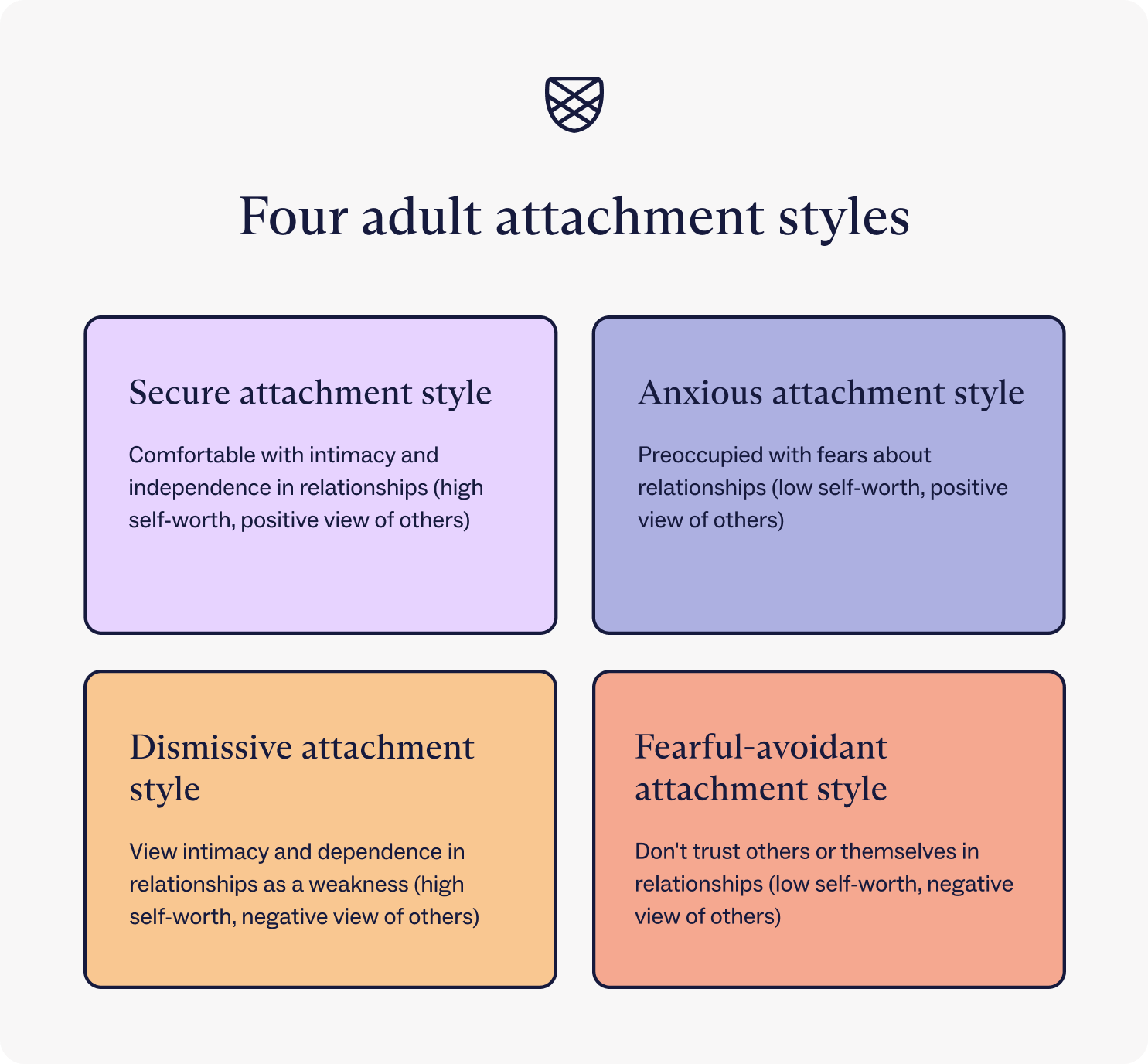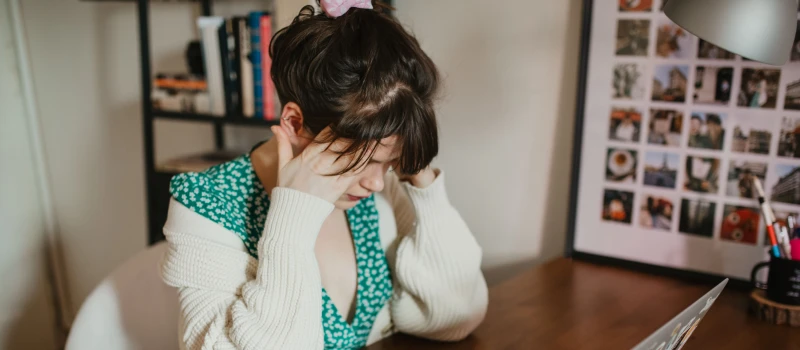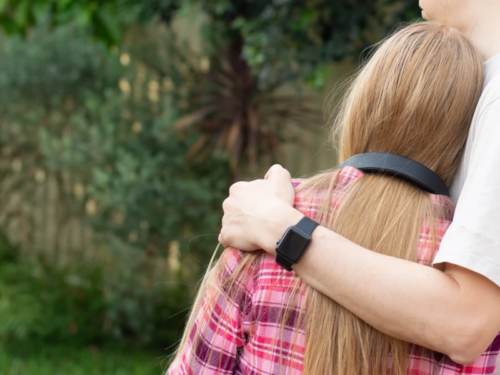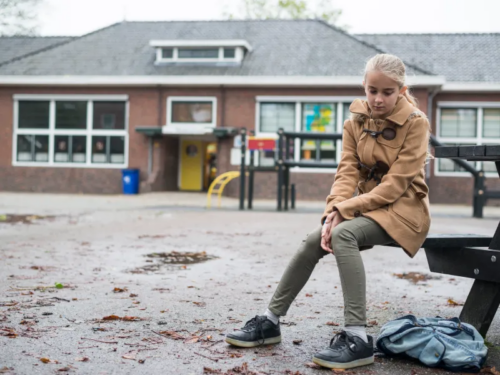
Table of Contents
Do You Have an Anxious Attachment Style?

Written By: Dr. Rasna Kaur Neelam

Clinically Reviewed By: Dr. Don Gasparini
Updated: September 13, 2023
7 min.
People with low self-esteem and a fear of rejection in relationships may have an anxious attachment style. Keep reading to review the signs and causes of anxious attachment, and take our attachment style quiz (linked below) to learn yours.
Learn more about our Clinical Review Process
Table of Contents
Attachment theory suggests that peoples’ bond with childhood caregivers lays the foundation for how they relate to future relationships—also known as their attachment style. A person’s attachment style describes the behaviors they showcase in relationships, including friendships, romantic relationships, relationships with family members, and more.
There are four main attachment styles: anxious attachment, avoidant attachment (also known as dismissive attachment), fearful-avoidant attachment (also known as disorganized attachment), and secure attachment. Knowing your attachment style can help you better understand why you feel certain emotions regarding relationships (not sure what your attachment style is? Check out our attachment style quiz).

This piece will focus on the anxious preoccupied attachment style, or anxious attachment style for short. If you think you or a loved one has an anxious attachment style, keep reading to learn more about how the anxious attachment style presents in relationships and tips for how to go from an anxious to a secure attachment style.
What does it mean to have an anxious attachment style?
All four of the attachment styles are defined by how people view themselves and how they view others. A person with an anxious attachment style tends to have a negative view of themselves and a hard time believing they are worthy of love. At the same time, they have a positive view of others. As a result, people with an anxious attachment style usually look to others for affirmation; their self-worth largely depends on external validation.
If someone has an anxious attachment style, it usually means they fear rejection. An anxiously attached person wants relationships but constantly worries about getting rejected by friends, romantic partners, and more.
Join the Charlie Health Library
Get mental health updates, research, insights, and resources directly to your inbox.
You can unsubscribe anytime.
Signs of anxious attachment style
In the research article introducing the four-category model of attachment styles, researchers asked students in an introductory social psychology course to fill out questionnaires about demographics, friendships, self-esteem, self-acceptance, sociability, relationships, and interpersonal problems. From this social psychology research, the four main attachment styles were borne. This research also defined some of the common signs of the anxious attachment style. Based on the students’ answers, we know that people with an anxious attachment style typically exhibit the following signs:
Emotional expression
A person with an anxious attachment style tends to express themselves emotionally. Examples of this behavior may include crying frequently or crying in the presence of others frequently. It may also include revealing private information about themselves easily, sometimes oversharing, and even making others uncomfortable.
Caring for others
As mentioned, people with an anxious attachment style tend to have a positive view of others. They care deeply for other people, sometimes to the point that they are taken advantage of in relationships.
Emotional dependence
People with an anxious attachment style tend to lean on others emotionally because they do not feel great about themselves. This can sometimes lead to codependency or other types of toxic relationships.
Low self-esteem
A person with an anxious attachment style typically lacks self-confidence and instead tries to find a sense of self through constant reassurance from others. This can lead them to be manipulated by others or lose sense of their gut instincts.
Anxious attachment style in relationships
Here’s an example of what an anxious attachment style looks like in relationships:
Sam is a senior in high school with an anxious attachment style. On the surface, they’re a straight-A student with lots of friends and a long-term relationship. But internally, things are different. They feel possessive of friends’ other friendships and have strong emotional reactions when their friends can’t hang out since they are worried about any kind of rejection and don’t want to be alone. They also read deeply into their partner’s emotions and need constant reassurance to stay in the relationship.
How does an anxious attachment style develop?
As mentioned, attachment theory posits that attachment styles are based on the type of care people receive early in childhood. In short, your adult attachment style is largely based on your childhood. As a result, the following parental behaviors may lead to a child with an anxious attachment style. However, it is also possible for a person without any of the following experiences to develop an anxious attachment style.
Inconsistent care
When parents are inconsistent in providing care and fail to respond consistently to their child's needs, it can create an environment of uncertainty and insecurity. Children with inconsistent caregivers may develop anxious attachment styles as they constantly seek reassurance and worry about the reliability of their caregivers' support.
Neglect or abuse
Children who experience neglect or abuse can face profound emotional challenges. Such traumatic experiences may lead to low self-esteem, as they may internalize feelings of worthlessness or undesirability. As they grow up, these children may develop an anxious adult attachment style, becoming anxious in relationships, fearing abandonment or mistreatment, and struggling to trust others.
Poor emotional regulation
Parents who struggle with anxiety, have difficulty regulating their own emotions, or lack appropriate emotional boundaries with their children, can contribute to the development of an anxious attachment style. Children often model their emotional responses after their caregivers. If caregivers have trouble managing their emotions or are excessively enmeshed with their child's emotions, it can lead to a child's difficulty in managing their own feelings and seeking external validation for emotional stability.

Does having an anxious attachment style mean I have an anxiety disorder?
In short: not necessarily. An anxious attachment style refers specifically to how someone approaches and navigates relationships. By contrast, an anxiety disorder is a diagnosable mental health condition marked by persistent, excessive worry or fear that significantly disrupts daily life. On top of relationship anxiety, some people with an anxious attachment style might also develop or be predisposed to anxiety disorders, but having one does not automatically lead to the other.
However, there may be some overlap between attachment-related anxiety symptoms and symptoms of anxiety disorders. People with an anxious attachment style exhibit behaviors like relationship anxiety, seeking excessive reassurance, fearing abandonment, or being highly sensitive to perceived rejection or criticism within their relationships. Similarly, people with an anxiety disorder often face uncontrollable and, at times, irrational worry, which tends to extend to many areas of life and disrupt daily functioning. Also, anxiety disorders typically include physical symptoms, like increased heart rate and muscle tension.
How to go from anxious to secure attachment style
Moving from an anxious to a secure attachment style is a process that usually requires self-awareness, personal growth, and the development of healthier relationship patterns. It’s important to be patient since this transition can take time and effort. However, remember that it is always possible to move from an anxious to a more secure attachment style. Here are some tips for anxiously attached people moving away from an insecure attachment style toward a more secure attachment style.
Seek therapy
People who want to move from an anxious to a secure attachment style will need to reflect on patterns of behavior and thinking associated with their attachment style—a process that can be easier with a licensed mental health professional. A therapist, especially one specializing in attachment issues or interpersonal relationships, can provide guidance, tools, and a safe space to explore and address the underlying causes of your anxious attachment.
In some instances, an anxious partner may also benefit from couples therapy, which gives both partners a chance to improve communication skills and provides insights into attachment dynamics within the relationship. Couples therapy can offer a supportive setting where an anxious partner may feel more secure working on relationship issues.
Develop emotional regulation skills
In order to go from an anxious to a secure attachment style, it’s important to learn to regulate your emotions so you respond to relationship stressors more calmly and thoughtfully. One way to do this is by developing a mindfulness practice to become more attuned to your emotions and reactions. You can also work on your communication skills, particularly in expressing your needs and boundaries effectively and in a regulated way. Measured and honest communication can lead to more secure and trusting relationships.
Seek secure relationships
Having a strong support system of people with secure attachment styles can provide a healthier model for your own attachment style, and help you move away from a more insecure attachment style. Emulate the behaviors of people with secure attachment styles in your relationships. This includes being reliable, responsive, and supportive to your friends and partners’ needs and feelings.
Trauma-informed therapy at Charlie Health for people with an anxious attachment style
If you or someone you know is struggling with an anxious attachment style stemming from trauma or anxiety, Charlie Health is here to help. Our virtual Intensive Outpatient Program (IOP) supports young people with complex mental health challenges through supported groups, individual therapy, and family therapy. We know that healing starts at the root, and sometimes that means better understanding your attachment style. Fill out this short form to get started today.





